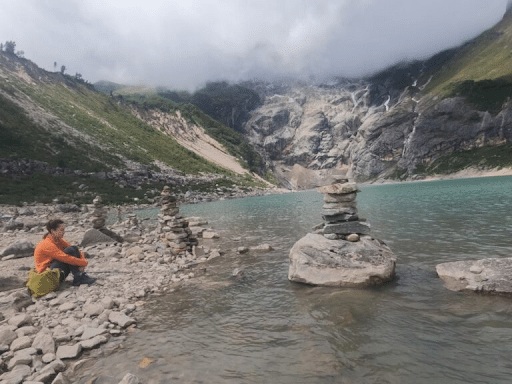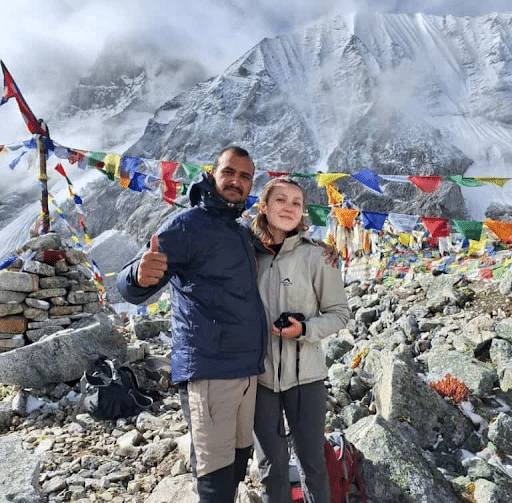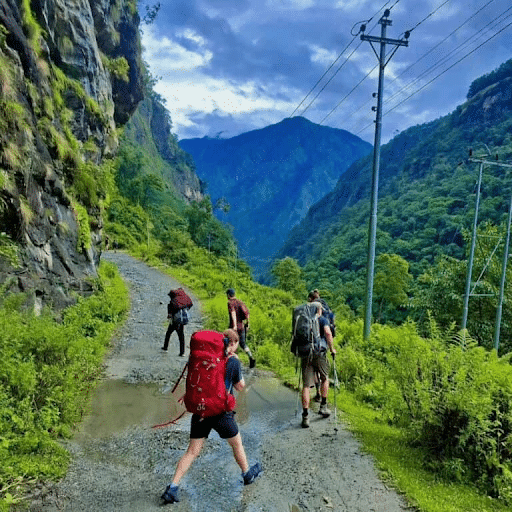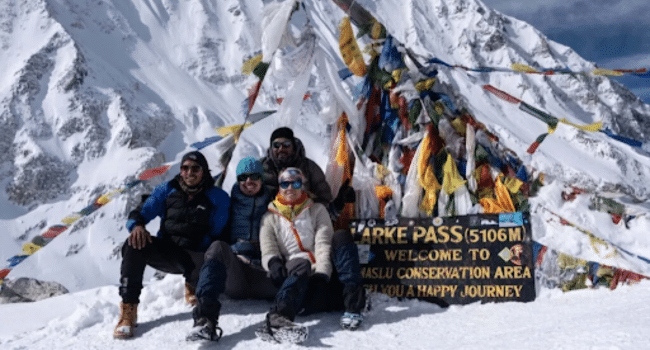Table of Contents
Nestled between the Annapurna and Langtang regions, the Manaslu Circuit Trek remains one of Nepal’s most pristine and less-commercialized trekking routes. Circling Mount Manaslu (8,163 m / 26,781 ft)—the world’s eighth-highest mountain—the circuit is often called Nepal’s “hidden gem.” Unlike the Everest Base Camp and Annapurna Circuit treks, which draw large crowds, Manaslu offers an authentic Himalayan experience where remote trails, traditional Tibetan villages, and dramatic landscapes converge.
For adventurers seeking the perfect balance of raw natural beauty and cultural immersion, this trek is a remarkable alternative to Nepal’s busier routes.
Key Highlights and Unique Features
- Remote and Unspoiled Trails – Experience authentic Himalayan trekking far from crowds.
- Mount Manaslu Views – Constantly changing perspectives of the 8th highest mountain.
- Larke La Pass (5,160 m) – A challenging high-altitude crossing with breathtaking views of Himlung Himal, Cheo Himal, and Annapurna II.
- Cultural Richness – Tibetan Buddhist villages, centuries-old monasteries, prayer wheels, and mani walls.
- Diverse Landscapes – From subtropical valleys and terraced farmlands to alpine meadows and glacial moraines.
- Wildlife Encounters – Potential sightings of snow leopards, Himalayan tahr, and blue sheep within the Manaslu Conservation Area.
Best Time to Visit Manaslu Circuit
Choosing the right season is key to enjoying the Manaslu Circuit Trek:
- Spring (March – May): Lush rhododendron blooms, clear skies, and moderate temperatures. Popular for photography.
- Autumn (September – November): Stable weather, crisp mountain views, and ideal trekking conditions. This is the peak season.
- W1inter (December – February): Fewer trekkers, but cold temperatures and heavy snow may make Larke Pass impassable.
- Summer/Monsoon (June – August): Heavy rains, leeches, and landslides in lower sections. Not recommended.
Best choice: Spring or Autumn for safe and scenic trekking. Where companies like Manaslu Trek Nepal have the best guide and facility to help you conquer the trek.
Permits and Regulations

The Manaslu region is classified as a restricted area, requiring special permits:
1. Manaslu Restricted Area Permit (RAP): Issued by the Department of Immigration, cost varies by season (approx. USD 100 for the first 7 days in peak season, USD 15/day thereafter).
2. Manaslu Conservation Area Permit (MCAP): USD 30.
3. Annapurna Conservation Area Permit (ACAP): USD 30 (since the trek exits via Annapurna).
Regulation note: Solo trekking is not allowed. A minimum of two trekkers with a licensed guide is required.
Detailed Itinerary: Day-by-Day
Here’s a standard 14–16 day Manaslu Circuit itinerary:
- Day 1: Kathmandu – Soti Khola (710 m)
Drive 7–8 hours via Arughat; overnight in Soti Khola. - Day 2: Soti Khola – Machha Khola (930 m, 6–7 hrs)
Trek along Budhi Gandaki River, forested trails, and suspension bridges. - Day 3: Machha Khola – Jagat (1,410 m, 6–7 hrs)
Ascend through hot springs and river crossings into the restricted zone. - Day 4: Jagat – Deng (1,804 m, 6 hrs)
Trail leads through subtropical forests and mani walls. - Day 5: Deng – Namrung (2,630 m, 6 hrs)
Enter Tibetan-influenced villages with stunning peaks in view. - Day 6: Namrung – Lho (3,180 m, 4–5 hrs)
Spectacular views of Manaslu and Ganesh Himal; visit Lho monastery. - Day 7: Lho – Samagaon (3,530 m, 4–5 hrs)
Panoramic views; acclimatization stop in Samagaon near Manaslu Base Camp. - Day 8: Acclimatization Day in Samagaon
Optional hikes: Manaslu Base Camp (4,800 m) or Birendra Lake. - Day 9: Samagaon – Samdo (3,860 m, 3–4 hrs)
Cross yak pastures and approach the Tibetan border region. - Day 10: Acclimatization or exploration in Samdo
Short hikes to surrounding hills or Rui La Pass viewpoint. - Day 11: Samdo – Dharamsala (4,460 m, 4–5 hrs)
Climb to the high camp before Larke Pass. - Day 12: Dharamsala – Larke La Pass (5,160 m) – Bimthang (3,720 m, 8–9 hrs)
The trek’s toughest day: cross the icy pass and descend into lush valleys. - Day 13: Bimthang – Tilije (2,300 m, 5–6 hrs)
Pass through alpine meadows and rhododendron forests. - Day 14: Tilije – Dharapani – Drive to Besisahar – Kathmandu
Connect to the Annapurna Circuit trail and return by jeep.
Difficulty Level and Preparation
The Manaslu Circuit is graded moderate to challenging:
- Daily trekking hours: 6–8 hrs on average.
- Maximum altitude: 5,160 m at Larke Pass.
- Risks: Altitude sickness, long ascents/descents, and cold conditions at high camps.
Preparation tips:
- Train with long hikes, cardio, and strength exercises 2–3 months before.
- Prior trekking at 3,000–4,000 m altitude helps.
- Mental endurance is as important as physical fitness.
Accommodation and Food

- Accommodation: Primarily teahouses—simple but cozy lodges run by local families. Rooms usually have twin beds and shared bathrooms.
- Food: Standard Nepali trekking fare including dal bhat (rice, lentils, vegetables), noodles, soups, momo (dumplings), Tibetan bread, and tea.
- Electricity & WiFi: Available in some villages, often with extra charges. Connectivity decreases as you go higher.
Essential Gear and Packing
- Clothing: Layered system—base layers, fleece, down jacket, wind/waterproof shell.
- Footwear: Broken-in trekking boots, sandals for teahouses.
- Accessories: Trekking poles, gloves, hats, sunglasses.
- Sleeping: Warm sleeping bag (–15°C comfort).
- Miscellaneous: Headlamp, water purification tablets, first aid kit, power banks.
Cultural Considerations

The region is heavily influenced by Tibetan Buddhism. Travelers should respect local customs:
- Walk clockwise around stupas and mani walls.
- Ask before photographing people.
- Dress modestly in villages and monasteries.
- Participate respectfully in local traditions and festivals.
Safety and Emergencies
- Altitude Sickness: Follow a proper acclimatization schedule, stay hydrated, and ascend gradually.
- Emergency Evacuation: Helicopter rescue available but expensive—travel insurance is essential.
- Trail Hazards: Rockfalls, landslides in monsoon, snow at high passes.
Costs and Budgeting
Approximate cost breakdown for a 14-day trek:
- Permits: ~USD 160 (RAP + MCAP + ACAP).
- Guide & Porter: Guide ~USD 25–30/day; Porter ~USD 20/day.
- Food & Accommodation: USD 25–40/day.
- Transport (Kathmandu–Soti Khola & return): USD 20–40 by bus/jeep.
- Miscellaneous (gear rental, WiFi, charging): USD 50–100.
Total estimate: USD 1,000–1,500 per person.
Comparison with Other Treks

- Everest Base Camp: More commercial, higher altitude (5,364 m), busy trails. Manaslu offers solitude and cultural authenticity.
- Annapurna Circuit: Easier logistics, more teahouses, but now accessible by road in many sections. Manaslu feels wilder.
- Langtang Valley: Shorter and less strenuous but lacks the high alpine challenge of Larke Pass.
Practical Tips from Experienced Trekkers
- Carry enough cash (no ATMs after Soti Khola).
- Start early on long days, especially Larke Pass.
- Bring snacks and energy bars for remote sections.
- Respect altitude—never rush.
- Hire local guides for authentic insights.
Conservation and Responsible Trekking
The Manaslu Conservation Area protects biodiversity and fragile ecosystems. Trek responsibly:
- Carry out non-biodegradable waste.
- Use refillable bottles instead of plastic.
- Support local teahouses and buy local produce.
- Respect wildlife and avoid disturbing habitats.
- Travel with eco-conscious trekking agencies.
Conclusion: Why Manaslu Circuit Should Be Your Next Trek
The Manaslu Circuit Trek offers everything an adventure traveler dreams of—majestic Himalayan peaks, cultural richness, physical challenge, and the reward of solitude.
It’s Nepal’s true hidden gem, striking the perfect balance between accessibility and remoteness. For those who want more than just a trek—a transformative journey into the heart of the Himalayas—this is the trek to choose.
